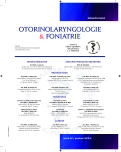Electrostimulation of Immobile Vocal Cord – Modification of the Method
Authors:
J. Traboulsi 1; V. Štípková 2; M. Perničková 2; T. Vaverková 2; J. Astl 1
Authors‘ workplace:
Oddělení ORL a chirurgie hlavy a krku, Nemocnice Na Homolce, Praha
1; Oddělení rehabilitační a fyzikální medicíny, Nemocnice Na Homolce, Praha
2
Published in:
Otorinolaryngol Foniatr, 62, 2013, No. 4, pp. 198-200.
Category:
Original Article
Overview
Electrotherapy is a component of physical therapy, where the therapeutic influence of various forms of electric energy is used. Impulse therapy is a part of electrotherapy, which makes use of therapeutic effects of precisely shaped current impulses. Since 2010 we included this method as a supplement in the therapy of patients with iatrogenic and idiopathic paresis of vocal cord. We made an attempt to modify the method in a way that would suit to our conditions and, at the same time, to reach maximum possible therapeutic effect. According to our experience the method can be considered as a suitable supplement of therapy in the above mentioned group of patients. It appears to be optimally used in connection with vocal cords therapy. The method is well tolerated by patients and significantly participates in the psychological component of therapy.
Keywords:
electrotherapy, impulse therapy, iatrogenic and idiopathic paresis of vocal cord
Sources
1. Capko, J.: Základy fyziatrické léčby. Grada, 1998, s. 155-193.
2. Gilman, M., Gilman, L. S.: Electrotherapy and the human voice: A literature review of the historici origins and contemporary applications. Journal of Voice, 22, s. 219-231.
3. Higgens, M. J. , Eaton, C. O.: Nontraditional applications of neuromuscular electrical stimulation. Athletic Ther. Today, 2004, 9, s. 6-10.
4. Iakovleva, I., Iliutovich, G. M., Iuvalova, N. D.: On the use of sinusoidal low-frequency modulated currents in vocal disorders in patients with paralysis and paresis of the laryngeal muscle. Vestn Otorinolaringol., 27, 1965, s. 93-98.
5. Lisa, A., LaGorio, M. S., Giselle, D., Carnaby-Mann, Michael, A. Crary.: Treatment of vocal fold bowing using neuromuscular electrical stimulation. Arch. Otolaryngolog. Head Neck Surg., 136, 2010, 4, s. 398-403.
6. Kučera, M., Frič, M., Halíř, M.: Praktický kurz hlasové rehabilitace a reedukace. 2010, s. 34.
7. Ptok, M., Strack, D.: Electrical stimulation – supported voice exercises are superior to voice exercise therapy alone in patients with unilateral recurrent laryngeal nerve paresis: results from a prospective, randomized clinical trial. Muscle Nerve, 38, 2008, 2, s. 1005-1011.
8. Ptok, M., Strack, D.: Klassische Stimmtherapie versus Elektrostimulationstherapie bei einseitiger Rekurrensparese. HNO, 53, s. 1092–1097.
9. Sanders, I.: Electrical stimulation of laryngeal muscle. Otolaryngol. Clin. North Am., 24, 1991, s. 1253-1274.
10. Ward, A. R., Shkuratvoa, N.: Russian electrical stimulation: the early experiments. Phys. Ther., 82, 2002, s. 1019-1030.
11. Zealear, D. L., Billante, Ch. L., Chongkolwatana, Ch., Herzon, G. D.: The effects of chronic electrical stimulation on laryngeal muscle Reinnervation. Journalfor Oto-Rhino-Laryngology and its related specialties, 62, 2000, s. 87-95.
Labels
Audiology Paediatric ENT ENT (Otorhinolaryngology)Article was published in
Otorhinolaryngology and Phoniatrics

2013 Issue 4
Most read in this issue
- Narrow Band Imaging (NBI) - Endoscopic Method for Head and Neck Squamous Cell Carcinoma Diagnostics
- Electrostimulation of Immobile Vocal Cord – Modification of the Method
- Surgical Treatment of Salivary Glands Tumor Lesions in the Five-Year Period
- Voice Range Profile Parameters in Diagnostics and Voice Research
